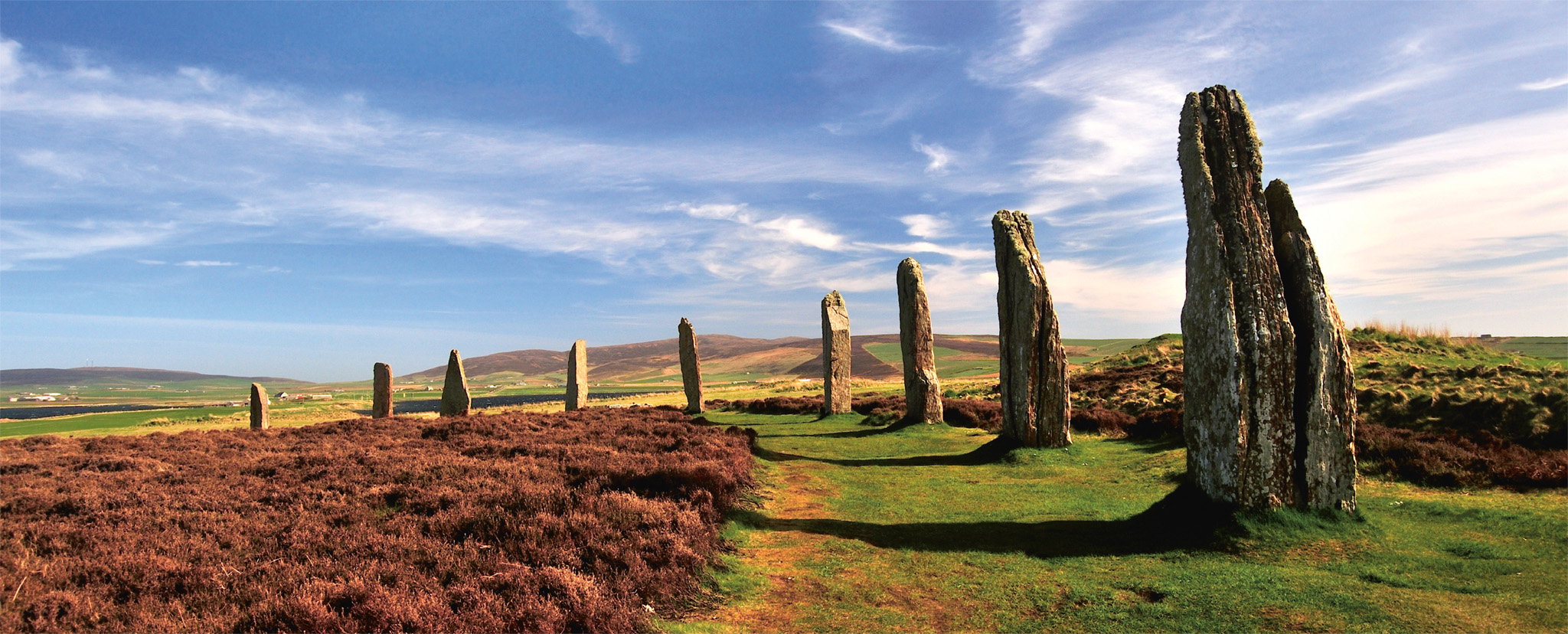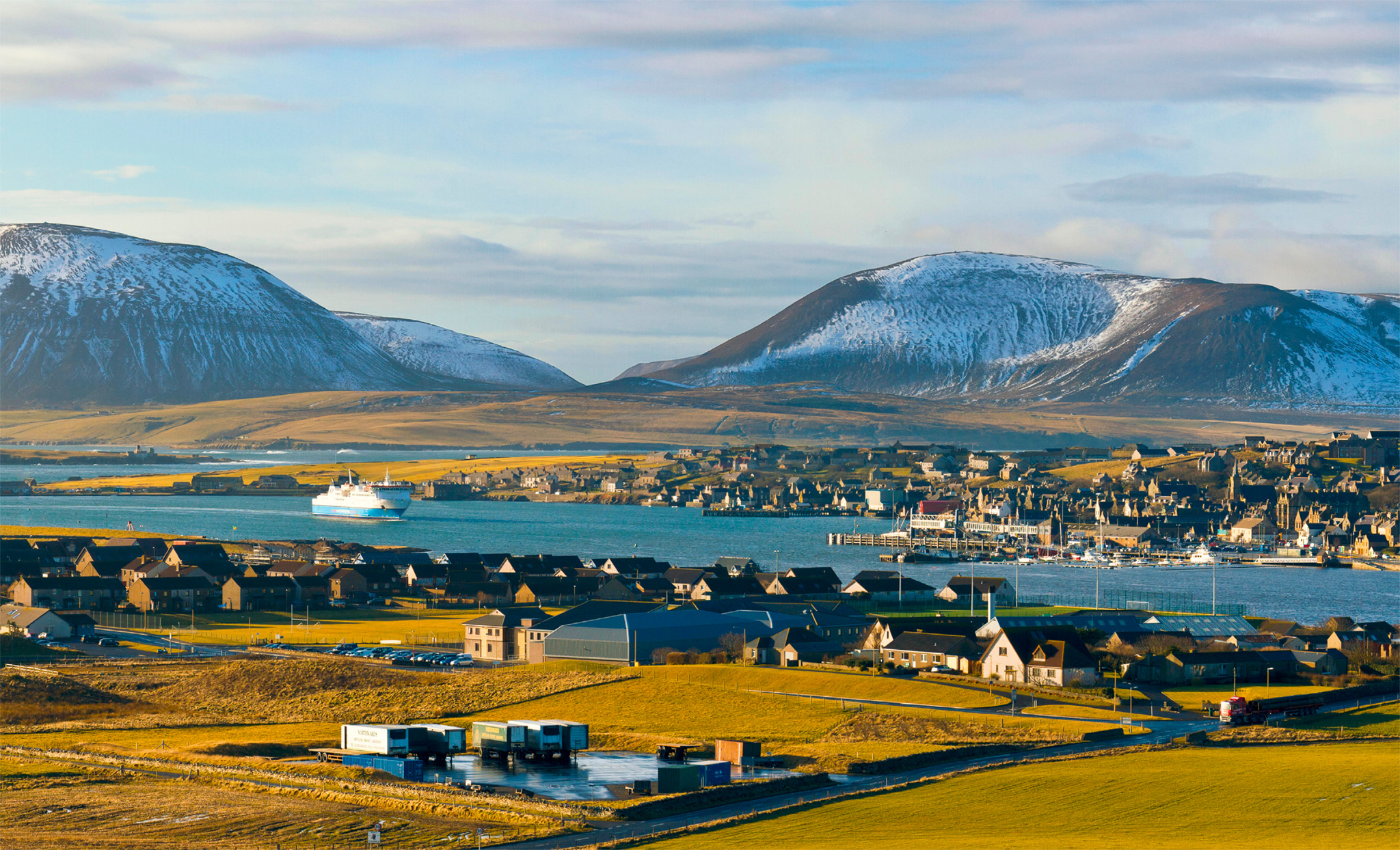D1, E1⌂ Orkney~ Kirkwallg From Scrabster or Gill’s Bay (Caithness), Aberdeen, Lerwick (Shetland), and John O’Groats (May–Sept only)n Kirkwall;
∑ visitorkney.com
Beyond the Pentland Firth, less than 10 km (6 miles) off the Scottish mainland, the Orkney archipelago consists of some 70 islands and rocky skerries boasting the densest concentration of archaeological sites in Britain. Today, only about 16 of these islands are permanently inhabited. Orkney’s way of life is predominantly agricultural – it’s said that, whereas the Shetlanders are fishermen with crofts, the Orcadians are farmers with boats.

t Ancient stone monoliths form the Ring of Brodgar Neolithic henge, Orkney
The Mainland is the archipelago’s main island, home to Orkney’s two largest towns, Kirkwall and Stromness. Almost 5,000 years ago, rings of colossal stone walls enclosed a complex of temples at Ness of Brodgar, the most recently rediscovered of Orkney’s Neolithic relics. In 1999, sites including the chambered tomb at Maeshowe and the Standing Stones of Stenness and the Ring of Brodgar were granted UNESCO World Heritage status, and archaeologists continue to unearth exciting finds that tell of a sophisticated ancient culture that flourished here long ago.
Hoy, Orkney’s second-largest island, takes its name from the Norse word for “high island”, which refers to its spectacular cliff-lined terrain. Hoy is very different from the rest of the archipelago, and its northern hills make excellent walking and bird-watching country.
Orkney’s outlying islands are sparsely populated and mostly the preserve of seals and seabirds. Rousay is known as the “Egypt of the North” for its many archaeological sites, and Egilsay was the scene of St Magnus’s grisly murder in 1115. The 12th-century round-towered church dedicated to his memory is a rare example of Irish-Viking design. Sanday is the largest of the Northern Isles, its fertile farmland fringed by sandy beaches, while North Ronaldsay, the northern most of the Orkney Islands, is noted for its hardy, seaweed-eating sheep and rare migrant birds.
Experience The Highlands and Islands

n Double-tap image to read the labels
Orkney’s capital is lined with period houses. Opposite St Magnus Cathedral, an 870-year-old masterpiece of red and yellow stone, lie the ruins of the Bishop’s Palace, dating from the 16th century. The Orkney Museum tells the history of the islands, while the Highland Park Distillery dispenses a fine dram at the end of its guided tours.
St Magnus Cathedral
" ' ⌂ Broad St # Mon–Fri
∑ stmagnus.org
Bishop’s Palace
" ⌂ Watergate # Apr–Sep: daily
∑ historicenvironment.scot
Orkney Museum
⌂ Broad St # Mon–Sat
∑ orkney.gov.uk
Highland Park Distillery
" ' = ⌂ Holme Rd # Times vary, check website
∑ highlandparkwhisky.com

t Orcadian town of Stromness with the hills of Hoy in the background
Many of the waterfront buildings in Stromness date from the 18th and 19th centuries. Among them, the Pier Arts Centre contains a fine collection of 20th-century works. The Stromness Museum traces Orkney’s history as a trading port.
Pier Arts Centre
= ⌂ 28–36 Victoria St # 10:30am–5pm Tue–Sat ∑ pierartscentre.com
Stromness Museum
⌂ 52 Alfred St # Daily (Nov–Mar: Mon–Sat)
∑ orkneycommunities.co.uk
Did You Know?
Captain Cook’s famous ships Discovery and Resolution moored in Stromness harbour in 1780.

Insider tip
Day Trips to Remote Islands
There are flights from Kirkwall to a dozen outlying islands several times a week, as well as daily ferries. Inter-island transport is weather-dependent.
Almost 5,000 years ago, rings of colossal stone walls more than 100 metres long enclosed the complex of temples at Ness of Brodgar, the most recently discovered of Orkney’s Neolithic relics. Said to date from around 2750 BC, Maeshowe is a chambered tomb aligned with the winter solstice. Vikings plundered it around 1150, leaving a fascinating legacy of runic graffiti on the walls. Nearby are the huge Standing Stones of Stenness and the Ring of Brodgar, a megalithic henge of 36 stones. The Neolithic village of Skara Brae was discovered when a storm stripped dunes from the site in 1850 to reveal relics of everyday Stone Age life. In 1999 these ancient sites were granted UNESCO World Heritage status.
The cliffs of Marwick Head, overlooking Birsay Bay, are one of several RSPB reserves on West Mainland, home to thousands of nesting seabirds in early summer. A memorial Commemorates Lord Kitchener and the crew of HMS Hampshire, which was sunk off this headland by a German mine in 1916.
East of Kirkwall, the road runs through quiet agricultural land over a series of causeways linking the southernmost islands to Mainland. The Churchill Barriers were built by Italian prisoners of war in the 1940s to protect the British fleet stationed in Scapa Flow. In their spare time, these POWs constructed the Italian Chapel, containing beautiful frescoes.
On South Ronaldsay, the 5,000-year-old Tomb of the Eagles, or Isbister Chambered Cairn, was discovered by a local farmer. Some 340 burial sites were later unearthed, along with stone tools and the talons of many sea eagles. The mile-long walk from the visitor centre to the tomb through a Bronze Age excavation site teems with birdlife and wild flowers.
The Old Man of Hoy, a 137-m (450-ft) vertical stack off the western coast, is the island’s best-known landmark, a popular challenge to keen rock climbers. Near Rackwick, the 5,000-year-old Dwarfie Stane is a unique chambered cairn cut from a single block of stone.

t Orkney’s iconic sea stack, the Old Man of Hoy is a popular rock climbing spot
On the eastern side of Hoy, the Scapa Flow Visitor Centre contains a fascinating exhibition on this deep-water naval haven. Temporarily rehoused in Hoy Hotel, the exhibition recounts the events of 16 June 1919, when the captured German fleet was scuttled on the orders of its commanding officer to prevent handover: 74 ships were sunk. Many have been salvaged; others provide one of the world’s great wreck-diving sites. Tours from Houton Pier, using a remote-controlled vehicle fitted with an underwater camera, give a glimpse of this sub-aquatic graveyard. Guided tours of the former Royal Naval Base depart at 11am every Tuesday and Thursday from the Ferry Waiting Room.
Experience The Highlands and Islands
|
STAY Merkister Hotel Only 15 minutes from Stromness and close to the Neolithic Orkney World Heritage Sites, this family-run hotel offers cosy rooms, exquisite home cooking set against fabulous sunset views. D1 ⌂ Harray ∑ merkister.com ]]] The Creel Multi-award-winning seafront B&B and restaurant in a timeless stone village. Quaint rooms and imaginative cooking – try the wolf-fish broth. E1 ⌂ St Margaret’s Hope ∑ thecreel.co.uk ]]] |
